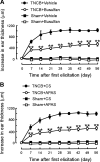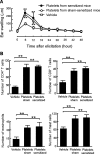The role of platelets in leukocyte recruitment in chronic contact hypersensitivity induced by repeated elicitation
- PMID: 17525269
- PMCID: PMC1899463
- DOI: 10.2353/ajpath.2007.060881
The role of platelets in leukocyte recruitment in chronic contact hypersensitivity induced by repeated elicitation
Abstract
Platelets have been shown to be important in inflammation, but their role in chronic allergic dermatitis remains unclear. To investigate the role of platelets in a mouse model of chronic contact hypersensitivity induced by repeated elicitation, mice were sensitized and repeatedly elicited in ears with hapten, with or without platelet depletion, by administering antiplatelet antibody or busulfan. Ear thickness, leukocyte infiltration, serum IgE, and scratching behavior significantly decreased in thrombocytopenic mice. cDNA microarray of ear tissue showed reduced gene expression associated with Th2 lymphocytes. Flow cytometry showed increased P-selectin expression on platelets and an increased number of platelet-leukocyte aggregates in blood of repeatedly elicited mice, compared with sham-sensitized mice. In thrombocytopenic mice, inflammation was restored by platelet infusion, which was blocked by platelets from P-selectin-deficient mice or by pretreating platelets with anti-P-selectin antibody. Moreover, injection of activated platelet supernatant into ears led to increased leukocyte infiltration, which was blocked by pretreating platelets with antiplatelet compounds or neutralizing several chemokines in the platelet supernatant. These results suggest that platelets induce leukocyte recruitment into skin by forming platelet-leukocyte aggregates via P-selectin in blood and secreting chemokines at inflamed sites. Therefore, controlling platelet activity may be useful for treatment of chronic allergic dermatitis.
Figures








References
-
- Schmitt-Sody M, Klose A, Gottschalk O, Metz P, Gebhard H, Zysk S, Eichhorn ME, Hernandez-Richter TM, Jansson V, Veihelmann A. Platelet-endothelial cell interactions in murine antigen-induced arthritis. Rheumatology. 2005;44:885–889. - PubMed
-
- Jeffery PK, Wardlaw AJ, Nelson FC, Collins JV, Kay AB. Bronchial biopsies in asthma: an ultrastructural, quantitative study and correlation with hyperreactivity. Am Rev Respir Dis. 1989;140:1745–1753. - PubMed
-
- Knauer KA, Fish JE, Adkindon NF, Jr, Lichtenstein LM, Peters SP, Newball HH. Platelets activation in antigen-induced bronchoconstriction. N Engl J Med. 1981;305:892–893. - PubMed
-
- Lupinetti MD, Sheller JR, Catella F, Fitzgerald GA. Thromboxane biosynthesis in allergen-induced bronchospasm: evidence for platelet activation. Am Rev Respir Dis. 1989;140:932–935. - PubMed
Publication types
MeSH terms
Substances
LinkOut - more resources
Full Text Sources
Other Literature Sources

